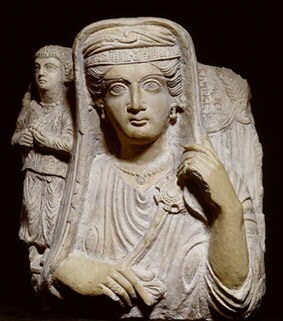Familiar Faces
During his work on the MARE Project, Bilal Annan has focused on Palmyrene funerary portraiture, adopting a dual approach: analyzing the iconographic features of the corpus of Palmyrene portraits and examining their archaeological context and ritual function.
The first aspect of his research explores the expression of emotions in Palmyrene funerary sculpture, emphasizing the striking emotional restraint in both portraits and epitaphs. The portraits, typically frontal and isolated, serve to materialize the presence of the deceased rather than convey grief. Likewise, funerary inscriptions prioritize genealogy and social status, with the common lamentation formula, ḥbl (“alas!”), possibly losing its emotional impact over time. However, rare exceptions – found in fewer than a hundred reliefs – depict affectionate gestures in family portraits, such as embraces, hand-holding, and mourning mothers following Near Eastern traditions. These gestures mainly appear in multi-figure compositions, whereas individual portraits emphasize dignity over emotion.
As part of this research, B. Annan co-organized a thematic panel with Lidewijde de Jong at the 2024 AIA Meeting in Chicago (January 5, 2024) on Ancient Emotions and Funerary Iconography in the Graeco-Roman Mediterranean. The panel featured case studies from diverse cultural contexts, including Imperial Rome, Asia Minor, and Classical Athens. This discussion led to a forthcoming edited volume, co-edited by B. Annan and L. de Jong, featuring contributions from several American and European classical art historians.
The second part of this research, conducted with L. de Jong, aimed to reconstruct funerary and commemorative rituals in Roman Palmyra and their connection to funerary portraits. Relying on excavation reports, archives, and correspondence with archaeologists, they cataloged in situ portraits and mapped sacrificial implements (plaster basins, altars, incense burners, lamps) across more than sixty tombs, including tower tombs, so-called “temple-tombs”, and hypogea. Each portrait was analyzed in relation to the ritual implements found nearby, while funerary epitaphs were examined for insights into the symbolic and ritual significance of these portraits. In epigraphy, portraits are commonly referred to as ṣlm (“image, statue”) and sometimes as nfš (“soul”), suggesting they may have represented a part of the deceased that endured beyond physical decay.
A key finding of this study concerns the spatial placement of ritual implements, particularly basins, which were sometimes found directly beneath individual funerary portrait slabs. The authors argue that these ritual objects were associated with the high social status of the individuals portrayed, indicating that they were honored with sacrificial offerings. In rare instances, basins were also discovered in lateral aisles, which were often purchased by families of supposedly lesser means. This suggests that certain prominent individuals within these social groups may have been venerated as “refounders” of family tombs, securing a form of posthumous prestige within their communities.
Researcher: Bilal Annan

| Last modified: | 25 February 2025 12.15 p.m. |
